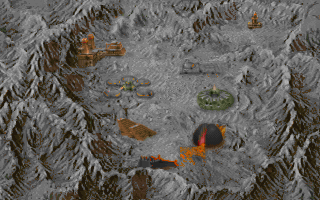![]()
The Environment
The surface of Phobos and Deimos are cold, dark and quiet places. Thick dust, in some areas as thick as 3ft deep make traversing the surface difficult. There is very little gravity on either rock, a 200 lb man on earth weighs a mere 2 ounces on Phobo's surface, less on Deimos. Add to that the complete lack of an atmosphere, venturing outside the complex's walls is a very dangerous task.

To protect the personnel inside the various stations located in the 6 mile wide crater called Stickney from cosmic debris, high impact plastics and light weight metal alloys were used.
To move about the complex effectively, weighted & magnetized boots must be worn. the temperature is kept at a constant 56.5 degrees Fahrenheit, any warmer and the radioactive sludge that the complex processes becomes volatile.
Listed are some of the stations within the Phobos Complex: the Hangar, Nuclear Plant, Toxin Refinery, Command Control, Phobos Lab, Central Processing, Containment Area, Refinery, Command Center as well as a Military Base
Mars Planet Profile
Diameter (miles)
Gravity (Earth=1)
Escape velocity
length of day
length of year
Atmosphere
Temperature (Fahrenheit)
Surface materials
3915.6
0.377
5000 m/s (16474.36 ft/s)
1.026
686.98 days
95% carbon dioxide, 3% nitrogen, 1.6% argon
68 to -220
basaltic rock and altered materials
Profiles of Phobos and Deimos

Phobos ("fear")

Deimos ("panic")
Mass (kg)
Size (miles)
Time to orbit Mars
Gravity (Earth=1)
Escape velocity
Atmosphere
Temperature (Fahrenheit)
1.08 (+/- 0.01) x 106
17x14x11
7hours 35min
0.0007
7.8 m/s (25.7 ft/s)
None
25 to -170 degrees
1.80 (+/-0.15) x 1015
9x7x6
30hours 18min
0.0004
4.7 m/s (15.5 ft/s)
None
23 to -175 degrees